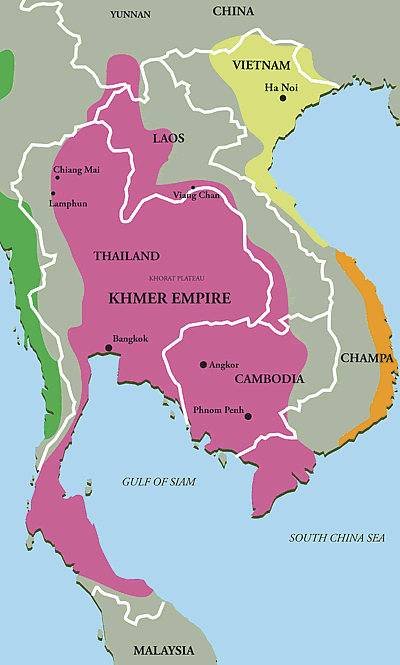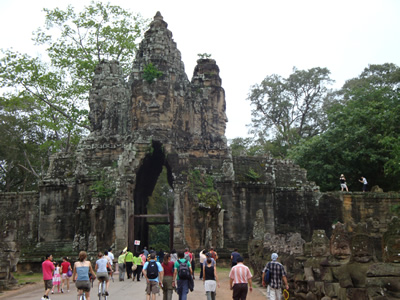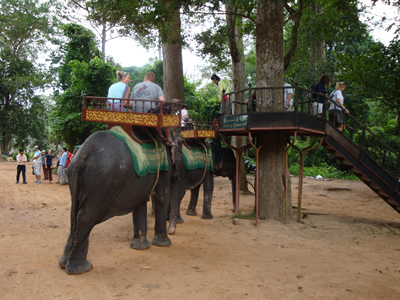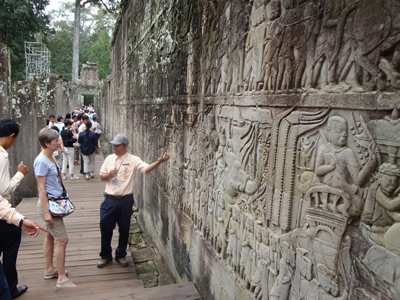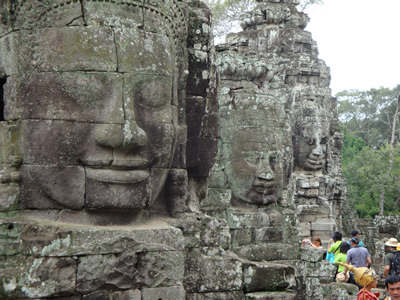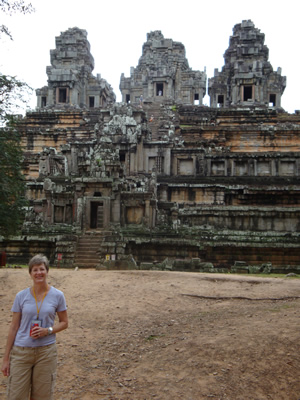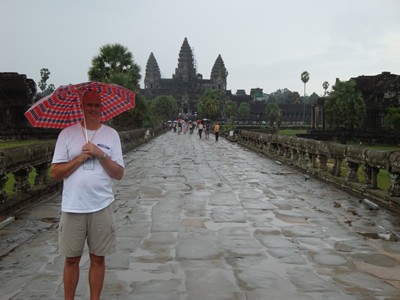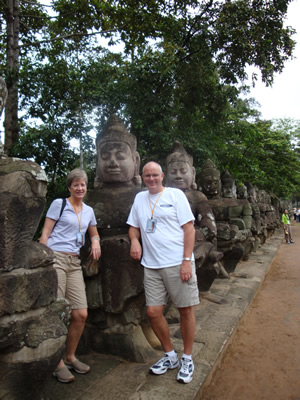Khmer Empire
The Khmer Empire was a great civilization that was centered on Cambodia. At it's height it covered most of modern day Cambodia and Thailand, as well as parts of Vietnam, Burma, China and Laos. It was the dominant power in Southeast Asia for six hundred years, from about 800 CE to about 1400 CE. Besides controlling a large land area it built many great monuments compararable to the pyramids of the Egyptians, the Mayans, the Incas or the Greeks and Romans of antiquity. But it's history is not well known in the West.
The Khmer Empire was founded by King Jayavarman II who unified Cambodia in 802 CE and ruled till 835 CE. I'm not sure how he could be Jayavarman the Second if he was the first king. One of those mysteries of history, I guess. He established the capital in Angkor in the Ruluos region, just a few miles from the modern city of Siem Reap. It was the center of the empire for most of its existence. Besides military expansion, many of the kings sponsored large building projects. Some of these were waterways and there are a number of canals and reservoirs (called barays) built in the area. But the most impressive are the great temples and monuments.
One of the greatest kings of the Khmer Empire was Suryavarman II, who ruled from 1113 to 1150. (Hint: In Khmer "varman" means "protector", a title which was taken by virtually all of the Khmer kings. Hence all their names end with -varman.) He is remembered by the Khmer for winning a great battle over the Cham people. The Kingdom of Champa was a rival of the Khmer Empire located in southern Vietnam in the Mekong delta region. Suryavarman II invaded and won a significant battle against the Cham and annexed some of their territory. He continued the invasion to try to subdue the entire Kingdom of Champa but was defeated and so had to settle for taking only a portion of the country. The monuments he built celebrate his victories and he is still remembered by Cambodians for his success in taking part of Champa, not his failure to take it all. Apparently the Khmer Empire had some pretty good PR people even that long ago.
He is most famous for his constuction of Angkor Wat, which is the largest religious monument ever built. It was originally a Hindu temple dedicated to Vishnu, who was believed to be personified on earth by the god-king, Suryavarman II himself (I told you he had a good PR department). The temple is surrounded by a square moat over five kilometers long and 190 meters wide and inside that by a high stone wall. The sandstone used in its construction was quarried many miles away and floated down the Siem Reap river on rafts. The structure of the entire complex represents Hindu cosmology. At the center is a huge pyramid which is symbolic of Mt. Meru, the center of the universe where divine spirits dwell. It has five towers corresponding to the five peaks of Mt. Meru. Surrounding the entire complex, the wall represents the mountains at the edge of the world and the moat the great ocean beyond the mountains. Construction took over thirty years but stopped when the king died in 1150. Some of the carvings and relief work were never finished. As a reference, Notre Dame de Paris was built at about the same time.
The greatest builder-king was Jayavarman VII, who ruled from 1181 to 1218. He built Preah Khan - I described our visit there in the last post. His most impressive achievement was the construction of a huge new capital city known as Angkor Thom. It is surrounded by an eight meter high wall, three kilometers on a side enclosing an area of nine square kilometers. At the center of each of the sections of the wall is a gate with a tower 23 meters high with the face of the Buddha looking down from all four sides of the tower. Leading to each gate is a causeway which is lined with stone figures. A Hindu myth popular in ancient Angkor was that of the Churning of the Sea of Milk. It told of a great tug of war fought between gods (devas) and demons (asuras) attempting to churn the ocean to obtain the elixr of immortality. On one side of the bridge the figures represent the good guys and on the other side the demons.
Within the area of Ankor Thom are many stone monuments and temples. The most famous is the Bayon which is located at the center. It is a large temple pyramid - again representing Mt. Meru. On the upper level of the pyramid are many stone towers adorned with the face of the Buddha. Originally there were 49 towers but only 37 have survived, with over 200 faces. The other striking feature of the Bayon is a series of bas-relief carvings which encircle the first level. These are incredibly detailed and go on for hundreds of feet. They show scenes from mythology as well as many scenes of battles, primarily against the Cham.
Unfortunately the cost of these massive construction projects by Jayavarman VII put a tremendous strain on the Khmer Empire. From that time on it began to decline. Angkor was fianlly attacked and sacked by the Thais in 1431, which is considered the end of the Khmer Empire. Two hundred years later for reasons still unknown, the city of Angkor was abandoned in 1609. Except for Angkor Wat, which continued as a Buddhist temple, all of the monuments of Angkor were overgrown by the jungle. Although known to local people, it was not until 1860, when Cambodia was part of French Indochina, that the French naturalist Henri Mouhot visited Angkor and began to popularize it in the West.
The second day of our trip was when we visited these incredible monuments. We started with a ride to one of the great gates leading into Angkor Thom. We got to pose with the statues on the causeway. We also climbed up onto the wall and got to look down on the hordes of tourists entering the gate. One tourist attraction there is an elephant ride from the gate to the Bayon - about a mile. We rode in our car instead. Not as cool but it had air conditioning.
The Bayon is fantastic. Pakdei gave us the background stories of the beautiful carvings around the first level. Then we climbed to the upper level with the towers and the many faces of Buddha. Some stories say that the great king Jayavarman VII himself was the model for the faces on the Bayon, looking down on the city of Angkor Thom. Our pictures don't do it justice. It was overcast and gray rock on a gray day just doesn't show up well. On the other hand, it was hot enough as it was and we heard that on sunny days in summer it could be unbearable. Even in the summer "off" season the Bayon was quite crowded.
But the Bayon was just the start. Just outside the Bayon was a large statue of the Buddha that was a very active shrine. From there we walked to the Phimeanakas. This temple was at the center of the palace of king Suryavarman I. A legend says that every night the king would lie in the highest chamber with a woman who was an incarnation of a naga. This gave him godly powers and authority over the land. Sandy and I climbed to the top but there was no one there but other tourists. It was quite steep. It looks easy, but the steps are maybe four inches wide and eight to twelve inches high. And because they have deteriorated, not all the steps are the full width. Definitely a third class scramble in mountaineering terms. But there was a great view from the top.
Next we walked by the Baphuon, a massive temple in bad disrepair. There is major restoration work going on so the temple is closed to visitors. From there we walked to the Elephant Terrace which looked out over the old Royal Square of Angkor. It is named for statues of three headed elephants but I thought the most impressive sculptures were the garudas and other figures that lined the walls.
From there we drove to Ta Keo, an even older, higher and steeper pyramid. Sandy was content to wait at the bottom and take pictures but as an old mountaineer I had to go to the top. In the very highest tower a Buddhist nun had a small shrine and was collecting donations for the upkeep of the temple.
Then we visited Ta Prohm. More than any of the other temples we visited, this one really gave the impression of the "lost city of the jungle". In many places trees were growing out of the walls and on top of the towers. In some places the roots are so intertwined with the structure that it is not clear how to restore the temple - the trees can't be removed without destroying the structure. Parts of the movie Tomb Raider were filmed in this ruin.
That was just our morning. We were hoping to do lunch on our own at the hotel but Pakdei had a lunch arranged for us. We were nervous as neither of us is very adventurous when it comes to food. But although a little unusual it turned out to be good. We had fish and rice balls with spice that gave them a real kick. It was pretty good. We enjoyed a chance to eat a slow lunch inside in airconditioning with a cold drink. We were soaked with sweat and wiped out just from walking around the temples all morning. I can't conceive how people could BUILD them in so much heat and humidity.
After lunch we went to Angkor Wat, by far the most famous of the temples. It is a source of great national pride and a picture of Angkor Wat is featured on the Cambodian flag. Just as we were getting out of the car it started to rain. But intrepid travelers that we are, we just pulled out our umbrellas. It rained hard on the approach over the bridge and on the long walk leading to the temple. Once there we were undercover. By the time we finished our tour around the temple it had pretty much stopped raining. While very impressive, I enjoyed the Bayon and the other temples that we had visited more than Angkor Wat. It is still very beautiful and I feel a little badly saying I liked the others better. Maybe it was the rain, or maybe I was saturated (in more ways than one) by that time. It's a little like saying something is "my least favorite painting in the Louvre".
We still had another temple visit on the agenda for the afternoon. Phnom Bakheng is on a hilltop with an impressive view. But since the weather was totally socked in and we wouldn't be able to see a thing, we skipped it and went into town early. We stopped at a huge souvenir store where we spent about an hour and a half. Sandy found some really nice jewelry (surprise!) while I got a wooden carving of the faces on the Bayon and a marble apsara dancer. Our choice of skipping the hilltop turned out to be the right one. While we were shopping it started to rain so hard that you could hardly talk, the rain on the roof of the store was so loud. It was pouring! And when someone who lives in Singapore is impressed by how hard it is raining, it means something.
Then it was back to the hotel to get cleaned up. We had a nice evening in the hotel bar with a glass of wine and some snacks. Another hard day of exploring and sightseeing.
